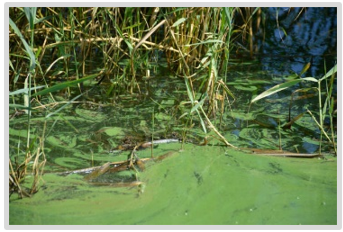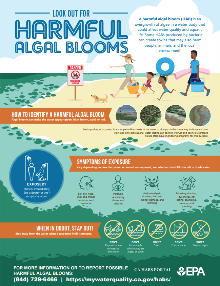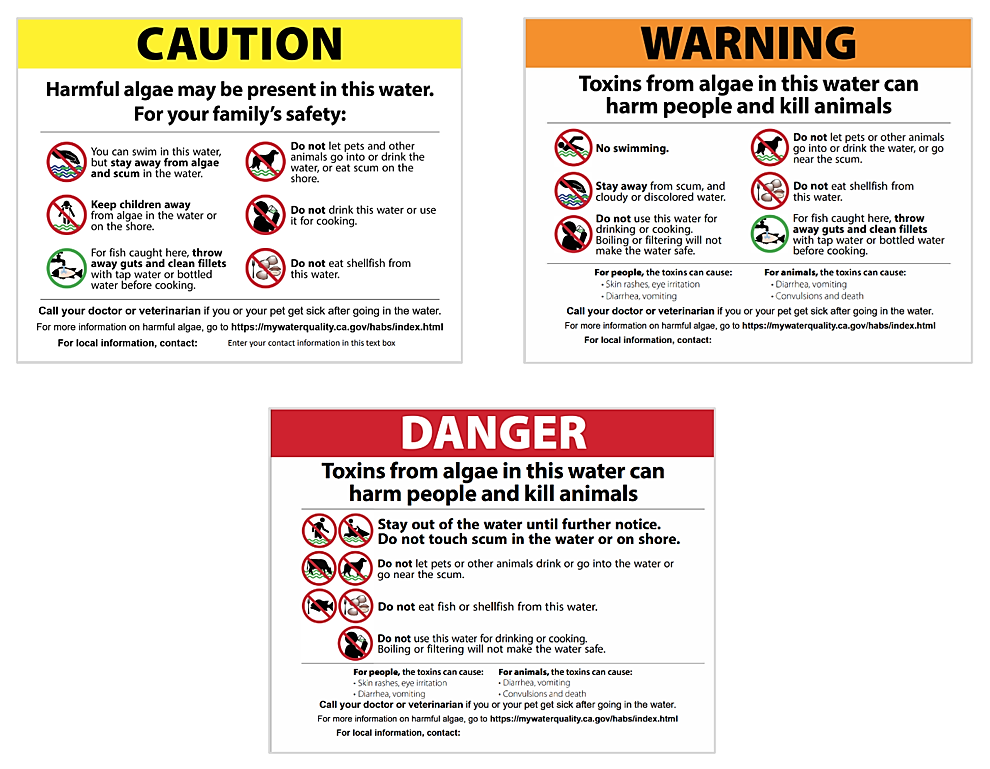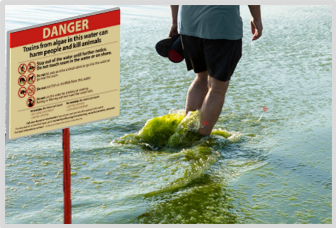Harmful Algal Blooms (HABs)
What are harmful algal blooms?
Harmful algal blooms occur when several types of bacteria (known as cyanobacteria) grow in fresh, brackish, or marine waters. Under certain conditions and with sufficient nutrients, some of these bacteria can rapidly reproduce and grow into large, visible blooms that may produce harmful toxins. Harmful algal blooms are often referred to as: cyanobacteria, blue-green algae, golden algae, or simply "algae."
Signs of harmful algal blooms
-

Bright green, blue, brown, or red color to the water. It may appear as though paint is floating on the water.
-
Cloudy water. However, the toxins may persist for days in the water even after the cells have died and the water appears to be clear.
-
Very bad odor, similar to a sewer smell or rotten eggs
-
Dead plants and/or fish
Health effects of harmful algal blooms
Some harmful algal blooms produce toxins that can poison humans and animals.
People who are exposed to harmful algal bloom toxins may experience:
- Skin rashes on contact with contaminated water
- Diarrhea and vomiting if contaminated water is ingested
- Harm to the liver, kidneys, or nervous system if the toxin levels are very high
Some cattle and dogs have died after consuming toxin-contaminated water or dried algae on the shoreline.
How to keep your family safe from harmful algal blooms
- Check if a waterbody has a reported bloom by checking the
HAB Reports Map, contacting the manager of the waterbody, and looking for posted advisory signs.
- If there are posted advisory signs, follow the recommendations on the signs.
-
Report any suspected HAB or potential HAB-related illness.
-
Stay away from the water when you suspect there is a harmful algal bloom. When in doubt, stay out.

|
View these educational resources:
|

|
CDPH worked with agency partners, tribal partners, and community members to create
advisory signs for harmful algal blooms.
See how we did it. You may find these advisory signs next to bodies of water that are contaminated with harmful algal blooms.
|
Our work on harmful algal blooms
 Our team investigates the health effects of harmful algal blooms and how cyanobacterial toxins may get into people and cause illness.
Our team investigates the health effects of harmful algal blooms and how cyanobacterial toxins may get into people and cause illness.
We participate in a multi-agency
Harmful Algal Bloom Illness Workgroup. When our workgroup is notified about a person who may have fallen sick from exposure to a harmful algal bloom, members of the workgroup will:
-
Interview the person who may have become ill from a harmful algal bloom.
- Direct regional coordinators to conduct environmental testing of a water body that may be contaminated by a harmful algal bloom.
- Determine whether an illness is related to a harmful algal bloom based on results of the interview and the testing of the water body.
- File any cases of human illness from a harmful algal bloom to the Center for Disease Control’s
One Health Harmful Algal Bloom System database.
We are also a member of the
California and Cyanobacterial and Harmful Algal Bloom Network of the California Water Quality Monitoring Council. This network advises local water body managers about monitoring and communication during harmful algal blooms.
Examples of investigations we conducted
- Our team conducted a study of recreational exposure to cyanobacterial toxins in two lakes in Northern California with the Centers for Disease Control and Prevention. We found some evidence that dried algal mats can produce measurable toxin in the air.
- Our team tested for cyanobacterial toxins in fish and shellfish from Clear Lake during a 2015 algal bloom event. We found no evidence of toxin accumulation in the edible portion of the fish, crayfish, or clams.